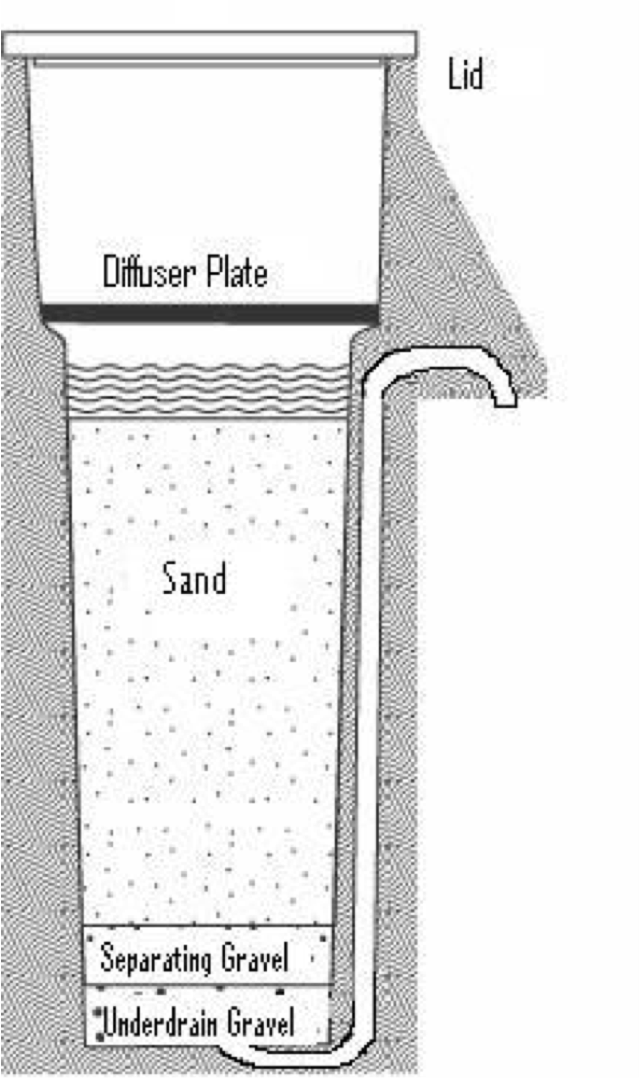Difference between revisions of "Concrete Biosand Filter"
| Line 53: | Line 53: | ||
The flow rate through the filter will slow down over time as the biolayer develops and sediment is trapped in the upper layer of the sand. For turbidity levels greater than 50 NTU, the water should first be strained through a cloth or sedimented before using the BSF. | The flow rate through the filter will slow down over time as the biolayer develops and sediment is trapped in the upper layer of the sand. For turbidity levels greater than 50 NTU, the water should first be strained through a cloth or sedimented before using the BSF. | ||
| − | + | ||
| − | |||
| − | |||
The treated water should be collected by the user in a safe storage container placed on a block or stand, so that the container opening is just under the outlet, minimizing the risk for recontamination. | The treated water should be collected by the user in a safe storage container placed on a block or stand, so that the container opening is just under the outlet, minimizing the risk for recontamination. | ||
| Line 94: | Line 92: | ||
Maintenance is required when the flow rate drops to a level that is inadequate for the household use. Swirl and dump maintenance for the top layer of sand is simple, takes a few minutes and can be done by household users. The frequency of swirl and dump depends on turbidity of inlet water. The outlet, lid and diffuser should be cleaned on a regular basis. | Maintenance is required when the flow rate drops to a level that is inadequate for the household use. Swirl and dump maintenance for the top layer of sand is simple, takes a few minutes and can be done by household users. The frequency of swirl and dump depends on turbidity of inlet water. The outlet, lid and diffuser should be cleaned on a regular basis. | ||
| + | |||
| + | The outlet should also be cleaned regularly using soap and water or a chlorine solution. | ||
====Manufacturing==== | ====Manufacturing==== | ||
Revision as of 09:39, 28 July 2009
Water treatment is carried out by the sand inside the filter. The filter container can be made of concrete, plastic or any other water-proof, rust-proof and non-toxic material.
The concrete BSF typically uses a box about 0.9 m tall by 0.3 m square, or about 0.3 m in diameter. The filter box is cast from a steel mold or made with pre-fabricated pipe. The container is filled with layers of sieved and washed sand and gravel (also referred to as filter media). There is a standing water height of 5 cm above the sand layer. Similar to in slow sand filters, a biological layer of microorganisms (also known as the biolayer or schmutzedecke) develops at the sand surface, which contributes to the water treatment.
A perforated diffuser plate or basin is used to protect the biolayer from disturbance when water is poured into the filter.
Pathogens and suspended material are removed from the water through a combination of biological and physical processes. These occur both in both the biolayer and within the sand bed. These processes include: mechanical trapping, adsorption/attraction, predation and natural death.
History and social context
Suitable conditions
It is suitable to process batches of 12-18 litres. If four batches a day are filtered, this provides 24-72 litres of clean water.
|
|
Technical specification
Operation
Contaminated water is poured into the top of the filter on an intermittent basis. The water slowly passes through the diffuser, and percolates down through the biolayer, sand and gravel. Treated water naturally flows from the outlet.
The biolayer is the key pathogen removing component of the filter. Without it, the filter is significantly less effective. It may take up to 30 days to establish the biolayer depending on inlet water quality and frequency of use. The water from the filter can be used during the first few weeks while the biolayer is being established, but disinfection is recommended during this time, as during regular on-going use.
The biolayer requires oxygen to survive. When water is flowing through the filter, dissolved oxygen in the water is supplied to the biolayer. During pause times, when the water is not flowing, the oxygen is obtained by diffusion from the air.
Correct installation and operation of the biosand filter has a water level of approximately 5 cm above the sand during the pause period. A water depth of greater than 5 cm results in lower oxygen diffusion to the biolayer. A water depth less than 5 cm may evaporate quickly in hot climates and cause the biolayer to dry out.
A pause period is needed between uses to allow time for the microorganisms in the biolayer to consume pathogens in the water. The recommended pause period is 6 to 12 hours with a minimum of 1 hour and maximum of 48 hours.
The biosand filter has been designed to allow for a filter loading rate (flow rate per square metre of filter area) which has proven to be effective in laboratory and field tests. This filter loading rate has been determined to be not more than 600 litres/hour/square metre.
The maximum recommended flow rate for the concrete biosand filter is 0.6 litres/minute measured when the inlet reservoir is full of water. If the flow rate is much faster, the filter may become less efficient at removing pathogens. If the flow rate is much slower, the user may become impatient and not use the filter even though the filter is working well at removing pathogens. Since the flow rate is controlled by the size of the sand grains, it is very important to select, sieve and wash the sand properly.
The flow rate through the filter will slow down over time as the biolayer develops and sediment is trapped in the upper layer of the sand. For turbidity levels greater than 50 NTU, the water should first be strained through a cloth or sedimented before using the BSF.
The treated water should be collected by the user in a safe storage container placed on a block or stand, so that the container opening is just under the outlet, minimizing the risk for recontamination.
Treatment Efficiency
| Bacteria | Viruses | Protozoa | Helminths | Turbidity | Iron | {{{extra_Field}}} | |
|---|---|---|---|---|---|---|---|
| Laboratory | Up to 96.5% 12 | 70 to >99% 3 | >99.9% 4 | up to 100% 5 | 95% up to <1 NTU 1 | Not Available | |
| Field | 87.9-98.5% 67 | not available | not available | Up to 100% 5 | 85% 7 | 90-95% 8 |
The sand selection and preparation are critical to ensure flow rate and effective treatment. The treatment efficiencies provided in the above table require an established biolayer; it takes up to 30 days to establish the biolayer depending on inlet water quality and usage. The filter should be used every day to maintain the biological layer.
The best performance requires a consistent water source; switching sources may decrease treatment efficiency. The swirl and dump maintenance will reduce efficiency until the disturbed biolayer re-establishes itself.
The taste, odour and colour of filtered water is generally improved. The treated water temperature is generally cooler than water stored in a plastic container.
Maintenance
There are no moving or mechanical parts to break. The piping is embedded in concrete, protecting it against breaks and leaks. Cracks can sometimes be repaired.
Concrete filters are heavy (70 – 75 kg for thin wall version and 135 kg for heavy wall version). Poor transportation of filters can lead to cracking and/or breakage. Filters should not be moved after installation.
Maintenance is required when the flow rate drops to a level that is inadequate for the household use. Swirl and dump maintenance for the top layer of sand is simple, takes a few minutes and can be done by household users. The frequency of swirl and dump depends on turbidity of inlet water. The outlet, lid and diffuser should be cleaned on a regular basis.
The outlet should also be cleaned regularly using soap and water or a chlorine solution.
Manufacturing
Local production of filters is most common. Molds can be borrowed, rented, bought or constructed locally. Filters can be constructed at a central production facility, or in the community. Filter sand and gravel can be prepared (sieved and washed) on-site or nearby.
Materials required are
- Steel mold
- Sand, gravel, and cement
- Filter sand and gravel
- Copper or plastic outlet tubing
- Metal or plastic for the diffuser
- Metal or wood for the lid
- Water for concrete mix and to wash filter sand and gravel
- Miscellaneous tools (e.g. wrench, nuts, bolts)
- Facilities: Workshop space for filter construction
A skilled welder required to fabricate molds. Anyone can be trained to construct and install the filter. Individual householders can assist in constructing their own filters.
Working with cement and heavy molds is potentially hazardous and adequate safety precautions should be used. Concrete filters are heavy and difficult to move and transport.
Estimated Lifespan
The estimated lifespan is 30+ years; existing filters are still performing satisfactorily after 10+ years. Lids and diffusers may need replacement.
Suppliers
Free mold designs are available from CAWST
Cost
| Captial Cost | Operation Cost | Replacement Cost | Estimated 5 years Cost | Cost/liter treated |
|---|---|---|---|---|
| US$ 12-30 | US$ 0 | US$ 0 | US$ 12-30 | US$ ~0.01 |
Note: Program, transportation and education costs are not included.
Country experiences
Manuals
Movies
Footnotes
- ↑ 1.0 1.1 Buzunis (1995)
- ↑ Baumgartner (2006)
- ↑ Stauber et al. (2006)
- ↑ Palmateer (1997)
- ↑ 5.0 5.1 Not researched. However, helminths are too large to pass between the sand, up to 100% removal efficiency is assumed.
- ↑ Earwaker (2006)
- ↑ 7.0 7.1 Duke & Baker (2005)
- ↑ Ngai et al. (2004)
Acknowledgements
This article is based on a factsheet from Centre for Affordable Water and Sanitation Technology (CAWST), which is gratefully acknowledged.
External Links
CAWST (Centre for Affordable Water and Sanitation Technology)
References
- Buzunis, B. (1995). Intermittently Operated Slow Sand Filtration: A New Water Treatment Process. Department of Civil Engineering, University of Calgary, Canada.
- Baumgartner, J. (2006). The Effect of User Behavior on the Performance of Two Household Water Filtration Systems. Masters of Science thesis. Department of Population and International Health, Harvard School of Public Health. Boston, Massachusetts, USA.
- Duke, W. and D. Baker (2005). The Use and Performance of the Biosand Filter in the Artibonite Valley of Haiti: A Field Study of 107 Households, University of Victoria, Canada.
- Earwaker, P. (2006). Evaluation of Household BioSand Filters in Ethiopia. Master of Science thesis in Water Management (Community Water Supply). Institute of Water and Environment, Cranfield University, Silsoe, United Kingdom.
- Elliott, M., Stauber, C., Koksal, F., DiGiano, F., and M. Sobsey (2008). Reductions of E. coli, echovirus type 12 and bacteriophages in an intermittently operated 2 household-scale slow sand filter.Water Research, Volume 42, Issues 10-11, May 2008, Pages 2662-2670.
- Ngai, T., Murcott, S. and R. Shrestha (2004). Kanchan Arsenic Filter (KAF) – Research and Implementation of an Appropriate Drinking Water Solution for Rural Nepal. [Note: These tests were done on a plastic biosand filter]
- Palmateer, G., Manz, D., Jurkovic, A., McInnis, R., Unger, S., Kwan, K. K. and B. Dudka (1997). Toxicant and Parasite Challenge of Manz Intermittent Slow Sand Filter. Environmental Toxicology, vol. 14, pp. 217- 225.
- Stauber, C., Elliot, M., Koksal, F., Ortiz, G., Liang, K., DiGiano, F., and M. Sobsey (2006). Characterization of the Biosand Filter for Microbial Reductions Under Controlled Laboratory and Field Use Conditions. Water Science and Technology, Vol 54 No 3 pp 1-7.

|

